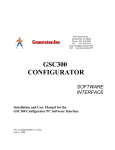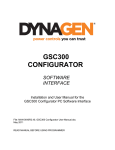Download GSC300 CONFIGURATOR - Powertech Engines Inc
Transcript
GSC300 CONFIGURATOR SOFTWARE INTERFACE Installation and User Manual for the GSC300 Configurator PC Software Interface File: ConfiguratorRev1.5.1.doc Mar.3, 2005 2 READ MANUAL BEFORE INSTALLING UNIT END-USER AGREEMENT FOR GSC300 Configurator PC software. GRANT OF RIGHTS DynaGen Technologies grants you the following non-exclusive rights: You may install and use the enclosed software product on your computer for reading and configuration of the GSC300 engine controller. You may not reverse- engineer, decompile, or disassemble the software product, except and only to the extent that applicable law notwithstanding this limitation expressly permits such activity. You may not rent or lease the software product. LIMITATION OF LIABILITY NO LIABILITY FOR CONSEQUENTIAL DAMAGES. To the maximum extent permitted by applicable law, in no event shall DynaGen Technologies or its suppliers be liable for any damages whatsoever (including, without limitation, damages for loss of business profit, business interruption, loss of business information, or any other pecuniary loss) arising out of the use of, or inability to use this software product. . We welcome your comments and suggestions. Please contact us at: DynaGen Technologies Inc. Phone: 1-888-396-2436 (902) 562 0133 Fax: (902) 567 0633 Email: [email protected] WEB SITE: www.dynagen.ca Installation and User Manual for the GSC300 Configurator PC Software Interface 3 Table of Contents WELCOME 4 INSTALLING THE GSC300 SOFTWARE Before you start. Minimum Hardware Requirements. Installing on Windows 98SE, 2000, ME, XP. CONNECTING YOUR GSC300 TO YOUR PC 4 USING THE GSC300 CONFIGURATOR PROGRAM Starting the Configurator program. GSC300 Configuration using Configurator. Load a Default Configuration File. Load a User Defined Configuration File. Manually Enter a Configuration File. Reading Data from the GSC300. Saving a Configuration File to Disk. Set Port Address. Customize Display Messages. GSC300 PROGRAMMING USING CONFIGURATOR Write data “as is” from a loaded configuration file. Write modified data from a loaded configuration file. Setting senders for input failures. 6 6 10 CONFIGURABLE FEATURES OF THE GSC300 13 TROUBLESHOOTING GUIDELINES 15 Installation and User Manual for the GSC300 Configurator PC Software Interface 4 CONFIGURATOR SOFTWARE INSTRUCTIONS Section 1 – Welcome The DynaGen Configurator PC software interface is a program that allows the programming and customization of DynaGen GSC300 AutoStart Engine Controller. The GSC300 can be programmed manually via front panel buttons OR with our easy-to-use PC software interface that allows customization of messaging; languages; sender selections; control settings; and much more. Although the GSC300 may be easily configured for common parameters from the front panel buttons, using the Configurator PC software interface allows full and more advanced programming capabilities. Section 2 – Installing the GSC300 Software 2.1 – Before you begin In order to install and use the DynaGen software, you should have a basic understanding of how to use your computer. If you do not, we recommend that you ask someone who does to help you, or that you read the user manual that came with your computer. If you encounter any problems or errors while installing the DynaGen Configurator software, please refer to Troubleshooting Guidelines On page15. 2.2 – Minimum Hardware Requirements For the DynaGen Configurator software to work reliably and efficiently, your computer must meet or exceed the minimum requirements specified in the following table: Operating System Windows 98SE, 2000, ME, XP. Processor Pentium or equivalent processor 64 MB RAM 20 MB Free Disk Space 256 colors at 1024x768 CD-ROM Drive ECP Printer Port Memory Hard Drive Video card display Peripherals Port Installation and User Manual for the GSC300 Configurator PC Software Interface 5 2.3 – Installing on Windows 98SE, 2000, ME, XP. 1. Exit all open applications, close any open windows, and disable any virus protection software before installing the DynaGen Configurator software. (Consult the instructions that came with your virus protection software.) If you have a previous version of the Configurator installed on your PC then you should uninstall the current version before installing this one. 2. Insert the DynaGen Configurator CD into your CD-ROM drive. Wait a few seconds, the Configurator installation program should start automatically. If the installation doesn’t start automatically, double click the my computer icon on your desktop, and then double-click the DynaGen Configurator icon. The Configurator installation program will start. 3. You are now presented with the main installation screen. Click the next button to install the Configurator software. 4. A process bar displays the Configurator software being copied to your hard drive. This may take several minutes depending on the speed of your computer and CD-ROM drive. You will also be asked to install two other modules required for operation. If you choose to not install one or more of the components then the Configurator will not operate as intended. Once Configurator is installed, you will need to restart your computer in order to start the DynaGen Configurator software. Remove the Configurator CD from your CD-ROM drive and then click OK on the dialog box asking you to restart. You have successfully installed DynaGen GSC300 Configurator program. If you have encountered any problems or errors while installing the software, please refer to Troubleshooting Guidelines on page 15 or call DynaGen technical support Hot Line at 1-902-562-0133. Installation and User Manual for the GSC300 Configurator PC Software Interface 6 Section 3 – Connecting the GSC300 to your PC. WARNING: NEVER CONNECT THE GSC300 PROGRAMMING CABLE INTO THE UNIT IF THE GSC300 IS POWERED ON. The GSC300 can be easily connected to your PC for Reading, Configuration and programming. The GSC300 has a Programming Connector, which is identified on the labeling, that can be plugged into the supplied programming cable. This cable must be plugged into the parallel port of the PC. Only connect the GSC300 programming cable into the unit if the GSC300 is powered off, installing the cable with the controller power on may damage the GSC300. The GSC300 programming cable is meant to adapt directly to the parallel port. Please be advised that the parallel port must be free from any connectors or adapters, which may be plugged into it. With the programming cable connected to both the GSC300 and your computers parallel port, the controller is now ready for programming. Please contact DynaGen if additional cables or programming connectors are required. Section 4 – Using the GSC300 Configurator Program. 4.1 – Starting the Configurator program 1. Click Start, Programs, DynaGen Technologies, then Configurator. 2. If there is a message stating that there was a problem with the parallel port, the user may have to choose the port address manually (see section 4.2.6 Set Port Address button feature on page 9). 3. You will now see the Configurator main screen window. Installation and User Manual for the GSC300 Configurator PC Software Interface 7 Configurator main screen window Installation and User Manual for the GSC300 Configurator PC Software Interface 8 4.2 – GSC300 Configuration using Configurator The Configurator main screen window gives the user many configuration options to program the GSC300. The user has the options to: 1. 2. 3. 4. 5. 6. 7. Load a Default Configuration File. Load a User Defined Configuration File. Manually enter Configuration Values. Read Configuration From The GSC300. Save a Configuration File to Disk. Set Port Address. Customize Display Messages. 4.2.1 – Load a Default Configuration File This option is recommended for most users. To load a default configuration file consisting of default factory values, click on the Load From Disk features button on the main screen window. Being certain the “Load Default” Box is selected, click OK. The default factory values will now be loaded into the “GSC CONTROL” frame window. These configuration settings may be stored to the GSC as is, or they may be modified by the user before writing. To abort loading the configuration file, click cancel. 4.2.2– Load a User Defined Configuration File To load a user defined configuration file (a configuration that the user saved to a file), click on the “Load From Disk” features button on the main screen window. Being certain the “Load Default” Box is not selected, choose the file from the location where it was previously saved, click OK. If the chosen file is a proper configuration file, the file will be loaded to the “GSC CONTROL” frame allowing it to be written to the GSC300. These configuration settings may be stored to the GSC as is, or the user before writing may modify them. If the chosen file was not a proper configuration file, a message “This is not a configuration file. Please choose another file.” Will be displayed in the text box at the bottom of the screen marked “Feedback.” To abort loading the configuration file, click cancel. 4.2.3– Manually entering Configuration settings A user can manually enter their own personal setting preferences by simply entering their preferences into the proper data locations in the “GSC CONTROL” frame window. Once the values are entered, they may be wrote to the GSC by clicking the “Store GSC Data” features button on the main screen window. Installation and User Manual for the GSC300 Configurator PC Software Interface 9 4.2.4– Reading data from the GSC300. The current configuration of the GSC300 may be read from the controller. This can be achieved by clicking on the “Read GSC Data” features button on the main screen window. If the GSC300 is connected properly to the PC the text boxes on the main screen within the “GSC CONTROL” frame will be loaded with the settings that was currently stored on the GSC300. The “Read GSC Data” features button allows for a complete data read, including previous saved sender types and associated values. The progress indicator will state “Settings successfully Read” to confirm proper reading. If there is an “Error Reading” popup message the data was not read properly, please refer to section 3 “Connecting the GSC300 to your PC” on page 6. These configuration settings may be modified by the user and stored back to the GSC by clicking the “Store GSC Data” features button on the main screen window. 4.2.5– Saving a configuration to disk. Any user entered configuration values may be saved to a file, so that the user may easily configure the GSC at a later time. These vales can be saved to a configuration file by simply clicking the “Save to Disk” features button on the main screen window. In the save to disk dialog box, simply type your chosen name in the lower left location bar. The file may be saved to the location specified by the user. If the user does not chose a specific location to save the configuration file, it will be saved to the default directory were the software was installed. If saving to a floppy, make sure the device is in the proper drive with available space for copying. *Please note there are certain files required by the program to operate. The files known as GSCConfig.ini, messages.ini and gauges.ini may not be overwritten with this option. It is critical that the user not modify these files. 4.2.6 - Set Port Address. The Configurator program will automatically detect the parallel port address on installation. If a problem occurs with detecting the port when installing Configurator the user may need to choose the port address manually. The user may set or change the address of the LPT port by clicking the “set port address” features button on the main screen window. The user has the option to select their address from the drop down list or manually enter the address in the text box window. If entering the address in the text box, the user must enter it as it is seen in the device manager. This can be preformed in the Control Panel, by clicking on System, hardware, followed by the Device Manager button. If an operating system is being used other then Windows XP, the user will have a Device Manager tab on the System window. Once in the Device Manager, expand the Ports branch, Right click on the Printer Port and hit properties. Clicking the resources tab under the Resource settings box, there should be at least one I/O Range listed. The lower value under “Setting” is the value the user needs to choose as the address for the Port. Installation and User Manual for the GSC300 Configurator PC Software Interface 10 4.2.7 - Customize display messages The user has the option to manually enter their own personal messages, which will be displayed, on the LCD screen. This can be achieved by clicking on the “Change messaging” features button on the main screen window. Once the change messaging dialog box appears simply enter the preferred messages into the proper custom message data locations. Clicking on the “Read” button will bring up the messages already stored in the GSC300. Once the values are entered or changed, they may be stored by clicking the “Store Messages” features button in the change messaging dialog box. The factory default messages can be restored be the user by simply highlighting the restore default messages check box. User customized messages can be saved for future use by clicking the “Save to Disk” features button in the change messaging dialog box. The user must choose a name for their customized file. Any saved user customized messages can be loaded by clicking on the “Load from Disk” features button in the change messaging dialog box. 4.3 – GSC300 Programming using Configurator The Configurator main screen window gives the user many options to program the GSC300. The user has the options to: 1. Write data “as is” from a loaded configuration file. 2. Write modified data from a loaded configuration file. 3. Choosing senders for failure inputs. 4.3.1 – Write data “as is” from a loaded configuration file. As explained in section 4.2 “GSC configuration using Configurator” values may be entered into the “GSC CONTROL” screen window by simply loading a default configuration or by using a user defined configuration file. If the user decides that the values are adequate for their application they may simply write these value to the GSC300 without any modifications. All the user has to do after they have loaded a configuration is click on the “Store GSC Data” features button on the main screen window. If there is a problem storing data to the GSC300, there will be an automatic “Write attempt”. The configurator will attempt to rewrite in a failed condition for a total of 3 times. The number of “write attempt” tries can be custom set for a minimum of 1 to a maximum of 10, found under the File menu. The programming status will be displayed on the status bar, in the bottom left corner of the main program window. The program will confirm programming success by displaying a “Finished Write” popup message. Installation and User Manual for the GSC300 Configurator PC Software Interface 11 4.3.2 – Write modified data from a loaded configuration file. As explained in section 4.2 “GSC configuration using Configurator” values may be entered into the “GSC CONTROL” screen window by simply loading a default configuration or by using a user defined configuration file. If the user decides that the values are not adequate for their application they may modify these value before written to the GSC300. All the user has to do after they have loaded a configuration is simply change the values that they wish, either by the pull down menu associated with each value or enter the value manually. Once the modifications are complete, click on the “Store GSC Data” features button on the main screen window. If there is a problem storing data to the GSC300, there will be an automatic “Write attempt”. The configurator will attempt to rewrite in a failed condition for a total of 3 times. The number of “write attempt” tries can be custom set for a minimum of 1 to a maximum of 10, found under the File menu. The programming status will be displayed on the status bar, in the bottom left corner of the main program window. The program will confirm programming success by displaying a “Settings successfully WRITTEN to you GSC” popup message. Installation and User Manual for the GSC300 Configurator PC Software Interface 12 4.3.3 – Setting Senders For Input Failures. The “Switch/Sender” screen window gives the user the option to choose how the GSC300 will recognize a low oil or high temperature failure. Failure values may be set for both low Oil and High Temperature levels by using the oil or temperature gauges themselves or choosing the values from a table, right from the “Switch/Sender” main window. If Fuel is chosen as a sender, there will be no requirement to choose the value point in the standard GSC300. The fuel as a sender would indicate the current level of fuel available. See a description of each sender below: 1. OIL: The oil Switch or Sender option determines how the GSC300 will recognize an oil failure condition. In the oil section of the “Switch/Sender” window the user is faced with both Switch and Sender options. If the user chooses the switch option, the GSC will use the value setting directly from the gauge (see gauge manufactures instructions for proper value settings). When the switch option is selected either NO (normally open) or NC (normally closed) may be choosing. In an NO condition the switch contacts will be normally open when the oil pressure is good, and closed when pressure reach below the choosing set point. In an NC condition the switch contacts will be normally closed when the oil pressure is good, and opened when pressure reach below the choosing set point. If the user chooses the sender option, the GSC will use a value that the user specifies from a setpoint table. When choosing the Sender option, the user must select the type of gauge being used from the dropdown list. After the gauge type has been selected the user may select a failure value by simply clicking the “setpoint” features button. The “setpoint” button will bring up a table with the values to choose from. These values will be in degrees Fahrenheit. After choosing the value that the GSC will recognize as a failure, click OK from the table window. Be advised that caution must be taken when choosing a failure value. Choosing a value that is too low would cause the GSC300 to never fail since the value of the sender would always be above the chosen failure set point. Choosing a value that is too high would cause the GSC300 to always fail since the value of the sender would always be below the chosen failure set point. Installation and User Manual for the GSC300 Configurator PC Software Interface 13 2. Temperature: The Temperature Switch or Sender option determines how the GSC300 will recognize a temperature failure condition. In the temperature section of the “Switch/Sender” window the user is faced with both Switch and Sender options. If the user chooses the switch option, the GSC will use the value setting directly from the gauge (see gauge manufactures instructions for proper value settings). If the user chooses the sender option, the GSC will use a value that the user specifies from a setpoint table. When choosing the Sender option, the user must select the type of gauge being used from the dropdown list. After the gauge type has been selected the user may select a failure value by simply clicking the “setpoint” features button. The “setpoint” button will bring up a table with the values to choose from. These values will be in PSI. After choosing the value that the GSC will recognize as a failure, click OK from the table window. Be advised that caution must be taken when choosing a failure value. Choosing a value that is too low would cause the GSC300 to always fail since the value of the sender would always be above the chosen failure set point. Choosing a value that is too high would cause the GSC300 to never fail since the value of the sender would always be below the chosen failure set point. 3. FUEL: The Fuel Switch or Sender option determines the level of fuel. When choosing the Sender option, the user must select the type of gauge being used from the dropdown list. When fuel is choosing as a sender it is used to indicate the current level of fuel available to the generator. Selecting Sender in the Fuel section of the “Switch/Sender” window does not require any settings or values in the standard GSC300. The GSC303 contains the options to set Low Fuel Shutdown of the engine, Low Fuel Pre-Alarm condition and a Fuel Overflow condition. Installation and User Manual for the GSC300 Configurator PC Software Interface 14 Configurable Features of the GSC300 Features Description Crank Disconnect Over-Speed This is the frequency at which the GSC300 will disengage the crank, keeping the fuel on to run the generator. This is the frequency when the GSC300 will shutdown the generator and indicate a failure. High Temp This is the value when the GSC300 will shutdown the generator and Setpoint indicate a high temperature failure. Low Oil This is the value when the GSC300 will shutdown the generator and Setpoint indicate a low oil pressure failure. Delay to Start This is a time in seconds that the GSC300 will wait before starting the generator. Preheat Time This is the time in seconds that the GSC300 will turn on the Extra relay, in order to preheat the generator. It is required that this option be enabled in order to be used. If this option is chosen, Warm-up or Energize to Stop (ETS) will not be available. Battery This is the value in Volts that the GSC300 will alarm a low battery Voltage level. This will not shut the generator down and will not generate a failure. Crank Tries This value is the number of attempts the GSC300 will crank over the generator. Crank Time This is the time in seconds the GSC300 will continue to crank over the generator. Oil Bypass This is the time in seconds the GSC300 will wait before checking to Time see if the Oil Pressure has reached a desirable level. Cool-Down This is the time in seconds the GSC300 will wait before shutting the Time generator down in order to allow sufficient cool down. Warm-Up This is the time in seconds the generator will keep the Extra relay Time off in order to allow the generator sufficient time to warm up. The extra relay would be used to turn on a load in this case. This option must be enable in order to be used. If this option is chosen, Preheat and ETS will not be available. Please note that this function will be activated after the Oil Bypass Time has expired. Rest Time This is the time in seconds the GSC300 will wait before attempting to turn the crank on for another crank attempt. Speed There are two types of speed sensing available to the GSC300. If Sensing Gen O/P is choosing then the speed detected is coming from the output of the generator. This will be a frequency range of 0-99 Hz. If MPU (Magnetic Pickup) is choosing, the speed detected is coming from the flywheel and is a frequency as high as 9000Hz. If MPU is chosen the frequency will not be displayed on the LCD. Installation and User Manual for the GSC300 Configurator PC Software Interface 15 Features Description Extra Relay If ETS is chosen the extra relay will be used as an Energize to Stop output. If preheat is chosen the extra relay will be used as a preheat output that will turn on for the user selected time before generator cranking. If ON is choosing then the fuel output will be left on during crank rest time. If this option is enabled when the engine goes into failure before the oil bypass time has passed, the GSC300 will re-attempt to start the generator. If this option is enabled then the extra relay will turn on for 7 seconds after the generator is up to its running speed. A mid-heat option is also automatically combined with post-heat which will be enabled during cranking. Fuel During Crank Rest Restart on False Start Post-Heat Configurable Features of Other GSC’s Note: For specific features of the GSC300 or other customized GSC’s please review the user manual for that product or contact Dynagen Technologies Inc. for more information. Features Product Providing Feature Description TDNE GSC302 TDEN GSC302 Low Fuel Shutdown GSC303 Low Fuel PreAlarm GSC303 Fuel Overflow GSC303 This is the time that the GSC302 will wait before engaging the transfer output to transfer power from utility to generator power. This is the time that the GSC302 will wait before engaging the transfer output to transfer from generator back to utility power. This is the fuel level at which the GSC303 will shut the engine down and prevent starting until the fuel is replenished to at least above the Low Fuel Shutdown level. This is the fuel level at which the GSC303 will turn on a front panel LED and the corresponding Annunciator output. This is the fuel level at which the GSC303 will turn on a front panel LED and the corresponding Annunciator output. Installation and User Manual for the GSC300 Configurator PC Software Interface 16 TROUBLESHOOTING GUIDELINES TROUBLE POSSIBLE CAUSE Message stating, “value was left blank”. Writing to the GSC300 with one Enter an appropriate value. of the value boxes in the “GSC CONTROL” left empty. Message stating that values doesn’t make sense. Writing to the GSC300 with a value that doesn’t make sense. Ex.-Crank Disconnect value larger than Over-speed. Enter an appropriate value. Message stating, “Need to choose set point”. Writing to the GSC300 with senders, but no set point chosen. A conflict with another program currently running on your computer. A problem with the auto-start feature. Enter an appropriate set point value. Computer locks or stalls during program installation. Program Installation does not start automatically when CD is placed in drive. SUGGESTED ACTION Exit all open applications, close any open windows, and disable any virus protection software. Double click the my computer icon on your desktop, and then double-click the DynaGen Configurator icon. Installation and User Manual for the GSC300 Configurator PC Software Interface 17 After installing Configurator the program will not start. The user needs to restart the computer Problem detecting computers parallel port during installation. Program not automatically detecting port address. Message stating “This is not a configuration file”. When reading the GSC300 a popup message stating “Error Reading” appears. Chosen file was not a proper configuration file. The GSC300 may not be properly connected to the PC Message stating, “Disk is full” when saving configuration files to disk. Trying to save to a CD Rom or disk that is full. Go to the start menu, followed by shutdown, Restart the computer Choose the port address manually by clicking the “set port address” features button. See section 4.2.6 Open a proper saved configuration file. Make sure the GSC300 is properly connected to the parallel port with the supplied cable. See section 3. Deleting files from the disk or using a disk with sufficient space. Installation and User Manual for the GSC300 Configurator PC Software Interface 18 TROUBLE POSSIBLE CAUSE SUGGESTED ACTION Message stating, “Device is not ready” when saving configuration files to disk. Constant Low oil failures. Trying to save to a CD Rom or disk that is not present. Make sure a disk is placed in the proper drive. • • Constant Temperature failures. • • Low oil level Choosing the sender setting value to high, causing the GSC300 to always fail since the value of the sender is always below the chosen failure set point. • • Add oil Choose a lower sender failure set point. Low coolant level Choosing the sender setting value to low, causing the GSC300 to always fail since the value of the sender is always above the chosen failure set point. • Add coolant Choose a higher sender failure set point. • Installation and User Manual for the GSC300 Configurator PC Software Interface





























